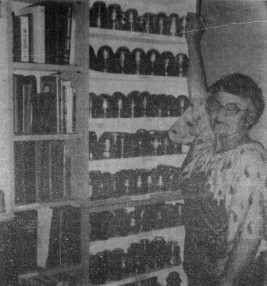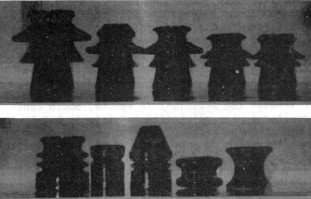Foreign Insulators
by Marilyn Albers
Reprinted from "INSULATORS - Crown Jewels of the Wire", January 1980, page 3
New Zealand Insulators Limited - NZI
When Lu Farin of Decatur,
Texas, received her July issue of Crown Jewels and saw the first article of a
series on foreign insulators, she went straight to her telephone and called me.
"I'm so excited that you're doing this," she said. "You must come
to see me. I have many foreign insulators. Perhaps I can help you with pictures
and information for your articles. We have lots to talk about -- come spend
several days! Bring your camera and notebook, and hurry!" Well, I'm not
very good at handling such messages calmly. I did six cartwheels and took off in
a cloud of turtle dust.

If this isn't proof of the common bond and the trust to
be found among insulator collectors, I don't know what is. We had never laid
eyes on each other before the day we met, and yet Lu took me in for two days,
gave me a bed and fed me, showed me all the truly unique and beautiful
insulators in her collection, and talked of her many trips to faraway places
with her husband Sheridon, and the fun they had collecting their prize pieces.
There are labeled display shelves which he built everywhere in the house, boxes
full in the garage, and, a couple of miles down the road, a large tin shed that
was specially built to house the many hundreds more that are in the collection.
I've never seen so many! Sheridon passed away a year ago, and yet Lu still keeps
up an avid interest in insulator collecting. She has also found room for a rock
collection, fossils, shells, arrowheads, and 3,000 pictures in all sizes and
shapes. It was really hard to decide where to begin and what to photograph. Too
much for a short visit, so I'll just have to make a few more trips to Decatur
(with Lu's permission).
As a result of
some trading we did, I came home with several new insulators to add to my
collection; but truly the best of all was finding a new friend, and a wonderful
one, at that. Thanks, Lu, it was a fun two days!
A trip to New Zealand in the
fall of 1972 with her husband was particularly fun for Lu. Though she had been
there with him once before on a business trip, he was now retired, and they had
more time for fun and hunting insulators.
A tour through the NZI plant in Temuka,
South Canterbury, New Zealand, resulted in several "gift" insulators;
but by far the greatest number came from picking up discards (including some
English porcelain) along the roads, dumped there by the power companies as they
were in the process of changing the lines. Pretty soon the power companies were
telling them ahead of time where they planned to dump so they could go get them.
Australia was on the itinerary, too, and as a result of their search there and
in New Zealand, they mailed back to the U.S.A. 100 boxes of insulators! (Now do
you believe me?) Those were some busy neighbors in Decatur. The boxes had to be
limited to 22 pounds, and only one a day could be delivered to any certain
address.
As you may know, New Zealand is an independent monarchial state
consisting of a series of islands in the southwest Pacific. New Zealand proper
consists of North Island, South Island, Stewart Island, Chatham Islands and
several smaller islands sometimes referred to as the Minor Islands.
North Island
and South Island are divided into several districts called Administrative Land
Districts. Canterbury is one of the districts of South Island, and in the
southern part we find the two NZI factories, one in Temuka and the other in
Ashburton.
Quoting from their catalogue: "From small beginnings 80 years
ago the Company has grown in size and technical ability until today it stands
out as the leader of the technical ceramic industry in New Zealand.
"All
products listed in this catalogue comply with relevant New Zealand or British
standards and high quality and dimensional accuracy and are ensured by the use
of the latest production methods and quality control techniques. Stringent
electrical testing is of course mandatory on high voltage insulators and the
Company has a well equipped test room for this purpose.
"In addition to
those items listed in the catalogue the Company will supply special ceramic
pieces to customer's requirements at highly competitive prices, and will
willingly give customers the benefit of its advice on problems connected with
the design and use of ceramics in any field."
NZI manufactures many types
of porcelain insulators -- low voltage and high voltage pin types, bobbin and reel
types, strain types, special insulators (i.e. "split" knobs, special
insulators for service into the house , etc.,), fuses, and wiring accessories.
Most of these insulators have a beautiful lustrous chocolate brown glaze. The
smaller pin type insulators (i.e. 4" tall) have the typical European
smaller size pin hole; but on the larger ones the pin holes are larger, too --
it's all relative.
I took several snapshots of Lu's NZI collection, but
unfortunately only a couple of them came out clear enough to see. (These are
reproduced on the following page.)

There are several variations of each
type pictured in the catalogue -- far too many to show here -- so I have selected a
representative drawing of each type.
Before I close
I would like to pass on a couple of facts that Grant Salzman (Sacramento,
California) was able to add to last month's article on Iran. The little Persian
glass insulators came from the village of YAZD -- right about in the center of
Iran. He has some of these for sale and also a few Russian glass and porcelain
insulators that were obtained from KURDS tribesmen (not Russian, as I had
stated) who frequently crossed the Russian-Iranian border.
| 